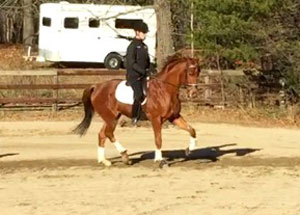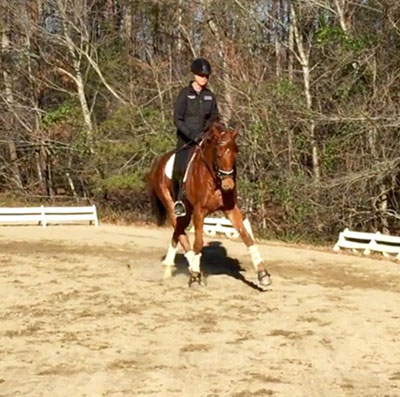Sometimes, when you have a very fresh youngster on a very fresh day, doing very fresh things.

one of the most effective things you can do is go forward,

forward,

Did I mention forward?

Forrest’s very favorite thing to do on these brisk, winter days, despite hours of turn out and thorough longeing beforehand, is, with no warning whatsoever, to go from a lovely, stretchy, warm-up trot to literally leaping through the air. It’s rather unseating! And when brought back to earth, he tends to want to balk at acceptance to my leg, so as shown above, my job is to remain calm and just send him forward. The next instant.
Not ready for a walk-to-canter request at this stage of his training, I go straight into rising trot, send him forward and back in quick, crisp, transitions on a circle, then sit, go right into canter, leave the circle and come bombing down the long side. I throttle back well before the corner, and leave the second short side with another big, forward, ride. The end result is that he then becomes extremely “on the aids,” as well as attentive to the stick figure on his back and no longer remotely interested in the squirrel near ‘F’ which sent him into orbit five minutes ago. I can now bring him back to a lovely, working canter that has quite a bit of sit in it as he just used his hind end in rather dramatic fashion a couple of minutes ago:

Following this, the trot he lands in is rather impressive. However, I now need to remind him of diagonal aids, too, not just forward. So as he lands in this dynamic trot, I recall a great piece of advice I was given during a clinic with Denny Callin years ago, when I was riding a very hot, sensitive, horse that I had allowed to run away from my leg: “Ride a 20-meter circle and make him leg yield off your inside leg with every step on the circle,” he suggested, “This way he must listen to your inside leg and as long as he’s moving sideways, he can’t run away from it.” And so with a quick half halt, Forrest and I began a 20 meter circle with him obliged to accept my inside leg all the way around:


And of course, after that nice reaction, along with the impulsion he was achieving, it seemed he might enjoy a burst of lengthening across a short diagonal:
The final piece of our session was testing if Forrest had used the correct muscles during our work out with a rewarding stretch for the cool-down. If he didn’t immediately seek my hand and follow the rein, then I know I didn’t have his back during our ride. But in the next step, he gratefully followed the invitation to let go and stretch, ending on a nice note indeed. Listen: it’s not unusual for OTTBs (or any 4 year old!) to get a little goofy during the winter months and I’m sure I’ll have many more challenging rides ahead until, say, July. So while perhaps I didn’t get a chance to work on the bit of shoulder-fore I had hoped to introduce, it was still a good day and reminded me to “ride the horse you have today!”
.jpg)











